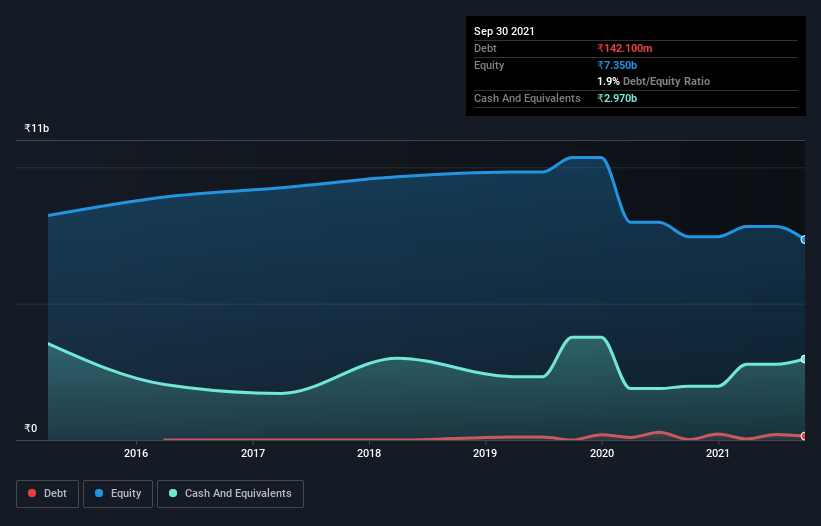Greaves Cotton (NSE:GREAVESCOT) Seems To Use Debt Quite Sensibly
Legendary fund manager Li Lu (who Charlie Munger backed) once said, 'The biggest investment risk is not the volatility of prices, but whether you will suffer a permanent loss of capital.' When we think about how risky a company is, we always like to look at its use of debt, since debt overload can lead to ruin. We note that Greaves Cotton Limited (NSE:GREAVESCOT) does have debt on its balance sheet. But is this debt a concern to shareholders?
When Is Debt Dangerous?
Debt assists a business until the business has trouble paying it off, either with new capital or with free cash flow. Ultimately, if the company can't fulfill its legal obligations to repay debt, shareholders could walk away with nothing. However, a more common (but still painful) scenario is that it has to raise new equity capital at a low price, thus permanently diluting shareholders. By replacing dilution, though, debt can be an extremely good tool for businesses that need capital to invest in growth at high rates of return. The first step when considering a company's debt levels is to consider its cash and debt together.
View our latest analysis for Greaves Cotton
What Is Greaves Cotton's Net Debt?
The image below, which you can click on for greater detail, shows that at September 2021 Greaves Cotton had debt of ₹142.1m, up from ₹17.5m in one year. But on the other hand it also has ₹2.97b in cash, leading to a ₹2.83b net cash position.

A Look At Greaves Cotton's Liabilities
Zooming in on the latest balance sheet data, we can see that Greaves Cotton had liabilities of ₹4.59b due within 12 months and liabilities of ₹592.5m due beyond that. Offsetting this, it had ₹2.97b in cash and ₹1.25b in receivables that were due within 12 months. So it has liabilities totalling ₹966.0m more than its cash and near-term receivables, combined.
Having regard to Greaves Cotton's size, it seems that its liquid assets are well balanced with its total liabilities. So while it's hard to imagine that the ₹48.4b company is struggling for cash, we still think it's worth monitoring its balance sheet. While it does have liabilities worth noting, Greaves Cotton also has more cash than debt, so we're pretty confident it can manage its debt safely.
The modesty of its debt load may become crucial for Greaves Cotton if management cannot prevent a repeat of the 85% cut to EBIT over the last year. When a company sees its earnings tank, it can sometimes find its relationships with its lenders turn sour. There's no doubt that we learn most about debt from the balance sheet. But it is Greaves Cotton's earnings that will influence how the balance sheet holds up in the future. So when considering debt, it's definitely worth looking at the earnings trend. Click here for an interactive snapshot.
But our final consideration is also important, because a company cannot pay debt with paper profits; it needs cold hard cash. While Greaves Cotton has net cash on its balance sheet, it's still worth taking a look at its ability to convert earnings before interest and tax (EBIT) to free cash flow, to help us understand how quickly it is building (or eroding) that cash balance. Over the most recent three years, Greaves Cotton recorded free cash flow worth 52% of its EBIT, which is around normal, given free cash flow excludes interest and tax. This free cash flow puts the company in a good position to pay down debt, when appropriate.
Summing up
While it is always sensible to look at a company's total liabilities, it is very reassuring that Greaves Cotton has ₹2.83b in net cash. So we don't have any problem with Greaves Cotton's use of debt. The balance sheet is clearly the area to focus on when you are analysing debt. But ultimately, every company can contain risks that exist outside of the balance sheet. We've identified 2 warning signs with Greaves Cotton (at least 1 which is potentially serious) , and understanding them should be part of your investment process.
At the end of the day, it's often better to focus on companies that are free from net debt. You can access our special list of such companies (all with a track record of profit growth). It's free.
New: Manage All Your Stock Portfolios in One Place
We've created the ultimate portfolio companion for stock investors, and it's free.
• Connect an unlimited number of Portfolios and see your total in one currency
• Be alerted to new Warning Signs or Risks via email or mobile
• Track the Fair Value of your stocks
Have feedback on this article? Concerned about the content? Get in touch with us directly. Alternatively, email editorial-team (at) simplywallst.com.
This article by Simply Wall St is general in nature. We provide commentary based on historical data and analyst forecasts only using an unbiased methodology and our articles are not intended to be financial advice. It does not constitute a recommendation to buy or sell any stock, and does not take account of your objectives, or your financial situation. We aim to bring you long-term focused analysis driven by fundamental data. Note that our analysis may not factor in the latest price-sensitive company announcements or qualitative material. Simply Wall St has no position in any stocks mentioned.
About NSEI:GREAVESCOT
Greaves Cotton
Operates engineering and mobility retail business in India, the Middle East, Africa, Southeast Asia, and internationally.
Adequate balance sheet with moderate growth potential.
Similar Companies
Market Insights
Community Narratives



